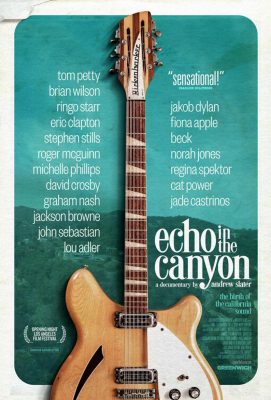 I can’t fathom the notion that a documentary about the origins of the “California Sound” from the sixties would be available for viewing in the cultural backwater of Orange County (CA). But there it was…a 12:45 showing in an Irvine Theatre that specializes in screenings of Bollywood epics. A bigger surprise was the notion that we had to stand in line to get tickets and that the theatre would be half-filled with a decidedly gray-haired audience.
I can’t fathom the notion that a documentary about the origins of the “California Sound” from the sixties would be available for viewing in the cultural backwater of Orange County (CA). But there it was…a 12:45 showing in an Irvine Theatre that specializes in screenings of Bollywood epics. A bigger surprise was the notion that we had to stand in line to get tickets and that the theatre would be half-filled with a decidedly gray-haired audience.
We survived interminable previews, Coca Cola ads, and cell phone warnings while an aerial view of Laurel Canyon opened to the lead riff to “Turn, Turn, Turn”. Feelings of nostalgia effortlessly mingle with thoughts that the CA sound began long before “Turn Turn Turn”, but logic surrendered to the glorious sound of a 12-String Rickenbacker.
The basic premise of this documentary is that something special happened in the hills of Laurel Canyon in the mid- sixties that would influence pop music for years to come. The sheer concentration of musicians in the community created a spirit of collaboration and experimentation that blossomed into an American Renaissance in popular music. Structurally, the film is divided into a series of interviews with key drivers of the music (Roger McGuinn, David Crosby, Stephen Stills. Michelle Phillips, Brian Wilson, Jackson Browne, John Sebastian, and Lou Adler. It is interspersed with concert and studio clips of Jakob Dylan, and other musicians paying tribute to the songs of this era.
It would be hard to argue that the 1965-67 time frame was not a gigantic leap forward in American rock music. At the core of “Echo” lies the communal nature of the various musicians that lived there. It was not uncommon for someone to drop by, guitar in hand, asking for feedback on their latest composition (driven home by the segment involving Stills and Eric Clapton talking about just how common it was for musicians to “borrow” from each other.
In the background of these segments, Dylan (and his collaborators) inject new life into these classic. Jade Castorinos’ vocals on “Go Your Own Way” are simply breathtaking. Can you imagine a banjo on the Byrds’ classic track, “Bells of Rhymney? Well, it works…50 years later. All of the “remakes” offer something new in a way that only reinforces the communal/global nature of music.
No doubt, this a boomer film. At the end, I was just blown away by the sense of music history and culture. It’s been a while since I’ve seen a film get applause. If you are fan of the “LA Sound”, this the film to watch.
I saw it in Houston a few weeks back. I found enjoyable, though some of the linkages between the artists that were covered (The Association as part of the Laurel Canyon scene?) seemed a bit tenuous. However, there was one bizarre element to the movie. Jakob Dylan kept talking about how part of the inspiration for his film came from watching the LA scenery presented in the 1968 film Model Shop. In fact, footage from that movie is intercut throughout the film and apparently was used as backdrop footage for an associated concert.
Model Shop is a rather obscure film, mostly remember as being the only American film made by Jacques Demy (A Man and A Woman). It has a soundtrack containing music by the LA band Spirit. Spirit appears in the film. For goodness sakes, there’s an album of Spirit’s music from the film. Yet despite that, Spirit gets zero mention in Echo in the Canyon. Maybe the Jakob and company felt that a group that wrote a song called “The Great Canyon Fire in General” wouldn’t fit in well with their film title. Or there may have been legal issues. For whatever reason, I thought it was a miss on their part to ignore Spirit.
By the way, if any LA residents really want to see how the city has changed over the last fifty years, find a copy of Model Shop and check out the opening credits scene. That rather tacky looking stretch of beachfront property shown you see was filmed on Speedway St.at Lighthouse Beach in Marina Del Rey. The protagonists house was located at 15 Outrigger St. (It’s gone now, replaced by a small apartment building). Go down there today, check out all the multimillion dollar homes and apartments and realize that a number of them must have been built on abandoned oil wells.